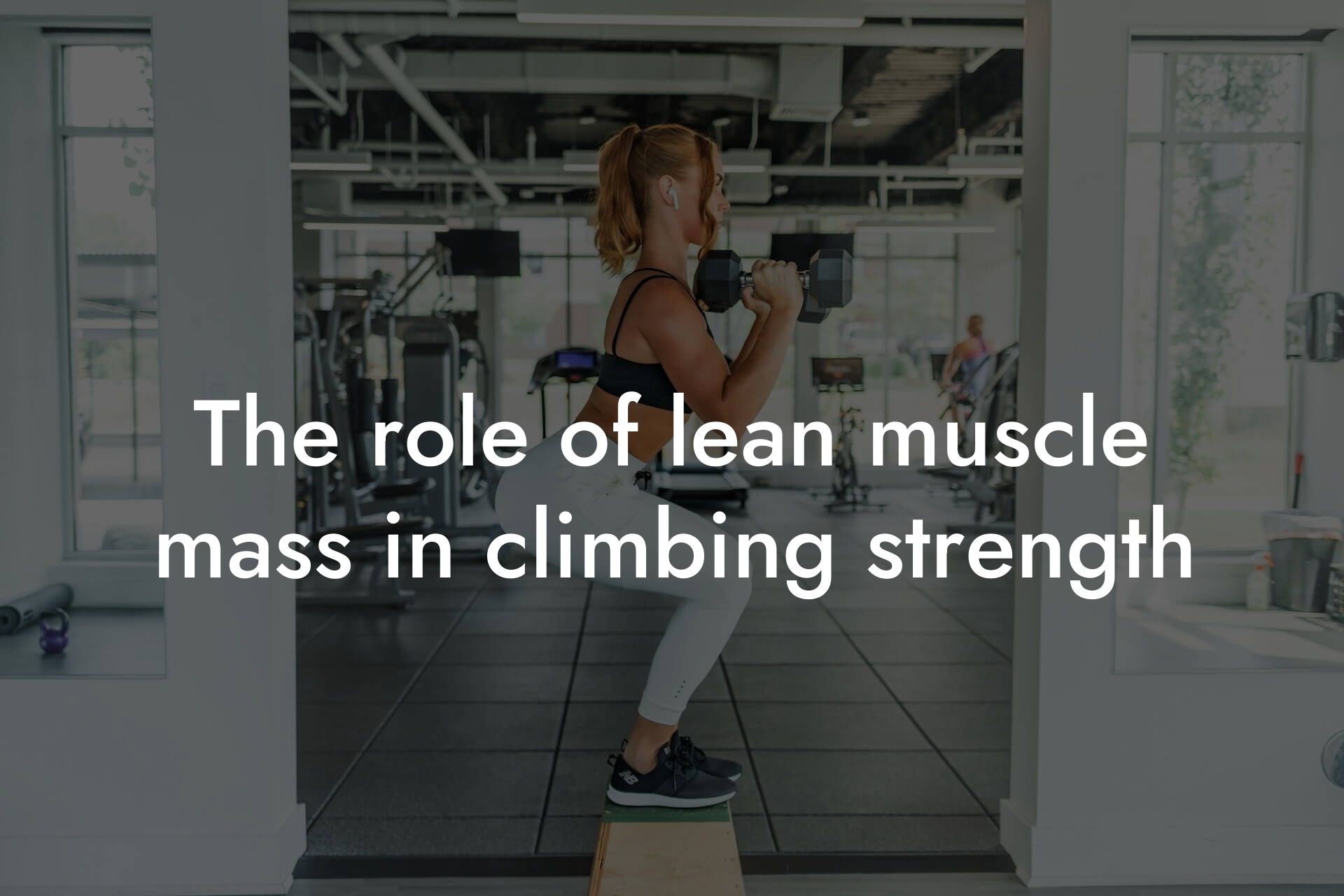As a climber, you understand the physical demands of the sport. Intense climbing sessions can leave you feeling exhausted, sore, and depleted. Proper recovery techniques are essential to restore your body, prevent injuries, and maintain performance. At Tano Performance Group, we recognize the importance of recovery in achieving your fitness goals. In this article, we'll explore the best recovery techniques for climbers after intense sessions, helping you to optimize your performance and reach new heights.
Table of Contents
Understanding the Importance of Recovery
Recovery is a critical component of any training program, and it's especially crucial for climbers. When you climb, you're not only challenging your physical strength and endurance but also putting your body under immense stress. Without adequate recovery, you risk experiencing fatigue, decreased performance, and increased risk of injury. Recovery allows your body to repair and adapt to the physical demands of climbing, making it essential for continued progress and improvement.
Immediate Post-Climb Recovery Techniques
In the immediate aftermath of an intense climb, it's essential to focus on reducing muscle soreness, replenishing energy stores, and promoting relaxation. Here are some techniques to incorporate into your post-climb routine:
- Stretching: Gentle stretching can help reduce muscle tension and improve flexibility. Focus on static stretches that hold the muscle in a lengthened position for 20-30 seconds.
- Foam Rolling: Self-myofascial release with a foam roller can help reduce muscle soreness and improve circulation.
- Hydration: Replenish lost fluids with water or a sports drink to prevent dehydration and promote recovery.
- Nutrition: Consume a balanced meal or snack that includes carbohydrates and protein to replenish energy stores and support muscle repair.
Active Recovery Techniques
Active recovery techniques involve low-intensity exercises that promote blood flow, flexibility, and relaxation without exacerbating fatigue. These techniques can be incorporated into your routine 1-2 days after an intense climb:
- Light Cardio: Engage in low-intensity cardio exercises like cycling, swimming, or jogging to promote blood flow and cardiovascular recovery.
- Yoga or Pilates: Gentle yoga or Pilates exercises can help improve flexibility, balance, and core strength while promoting relaxation.
- Easy Climbing: Engage in low-intensity climbing exercises like easy routes or bouldering to maintain climbing-specific movement patterns without exacerbating fatigue.
Passive Recovery Techniques
Passive recovery techniques involve minimal physical exertion, focusing on relaxation, rest, and rejuvenation. These techniques can be incorporated into your routine 1-2 days after an intense climb:
- Rest Days: Take complete rest days to allow your body to recover and rebuild.
- Compression Garments: Wear compression clothing to improve circulation and reduce muscle soreness.
- Massage: Treat yourself to a professional massage or use self-massage techniques to promote relaxation and reduce muscle tension.
- Ice Baths: Soak in an ice bath to reduce inflammation and promote recovery.
Recovery Nutrition
Nutrition plays a critical role in recovery, providing your body with the necessary building blocks to repair and adapt. Focus on consuming a balanced diet that includes:
- Carbohydrates: Replenish energy stores with complex carbohydrates like whole grains, fruits, and vegetables.
- Protein: Support muscle repair and growth with lean protein sources like lean meats, fish, and plant-based options.
- Healthy Fats: Include sources of healthy fats like nuts, seeds, and avocados to support hormone production and overall health.
- Hydration: Drink plenty of water to stay hydrated and support recovery.
Supplements for Recovery
Certain supplements can help support recovery, but it's essential to consult with a healthcare professional or registered dietitian before adding any new supplements to your routine. Some popular recovery supplements include:
- Protein Powder: Supports muscle repair and growth.
- Creatine: Enhances muscle strength and endurance.
- Branched-Chain Amino Acids (BCAAs): Reduces muscle soreness and fatigue.
- Omega-3 Fatty Acids: Supports inflammation reduction and overall health.
Monitoring Recovery
Monitoring your recovery is crucial to understanding your body's response to intense climbing sessions. Pay attention to:
- Heart Rate Variability (HRV): Monitor your HRV to track changes in your body's physiological response to stress.
- Sleep Quality: Track your sleep quality and duration to ensure you're getting adequate rest.
- Muscle Soreness: Monitor muscle soreness levels to adjust your training and recovery strategies.
- Performance Metrics: Track performance metrics like climbing speed, power, and endurance to monitor progress and adjust your training program.
Recovery is a critical component of any climbing training program. By incorporating these recovery techniques into your routine, you'll be able to optimize your performance, reduce the risk of injury, and reach new heights. Remember to listen to your body, adjust your recovery strategies as needed, and prioritize rest and relaxation. At Tano Performance Group, we're committed to helping you achieve your fitness goals. Take your performance to the next level with our comprehensive body assessment using DEXA technology.
Frequently Asked Questions
What is the importance of recovery techniques for climbers?
Recovery techniques are crucial for climbers as they help to repair and rebuild muscles, tendons, and ligaments that are damaged or stressed during intense climbing sessions. This allows climbers to return to their optimal performance level, reducing the risk of injury and improving overall climbing efficiency.
What are some common signs of fatigue in climbers?
Common signs of fatigue in climbers include muscle soreness, decreased strength, reduced endurance, and mental exhaustion. If left unaddressed, fatigue can lead to decreased performance, increased risk of injury, and burnout.
How soon should I start recovering after an intense climbing session?
It's essential to start recovering within 30-60 minutes after an intense climbing session. This allows you to replenish energy stores, reduce muscle soreness, and promote muscle repair.
What is the role of nutrition in recovery for climbers?
Nutrition plays a critical role in recovery for climbers. Consuming a balanced meal or snack that includes carbohydrates, protein, and healthy fats within 30-60 minutes after climbing can help to replenish energy stores, repair muscles, and support immune function.
What are some effective nutrition strategies for climbers?
Effective nutrition strategies for climbers include consuming a balanced diet that includes lean protein sources, complex carbohydrates, and healthy fats. Additionally, climbers should stay hydrated by drinking plenty of water, and consider supplementing with electrolytes, protein shakes, or creatine to support performance and recovery.
How does hydration impact recovery for climbers?
Hydration is essential for recovery in climbers, as it helps to replenish fluids lost during exercise, regulate body temperature, and support muscle function. Even mild dehydration can impair performance, increase muscle soreness, and delay recovery.
What is the importance of stretching and foam rolling in recovery for climbers?
Stretching and foam rolling are essential components of recovery for climbers, as they help to improve flexibility, reduce muscle soreness, and promote blood flow to damaged tissues. This can help to reduce the risk of injury, improve range of motion, and enhance overall climbing performance.
How often should I stretch and foam roll as a climber?
As a climber, it's recommended to stretch and foam roll 2-3 times per week, focusing on key muscle groups such as the shoulders, back, and legs. Additionally, incorporating dynamic stretching and mobility exercises into your warm-up and cool-down routines can help to improve flexibility and reduce the risk of injury.
What is the role of rest and sleep in recovery for climbers?
Rest and sleep are critical components of recovery for climbers, as they allow the body to repair and adapt to the physical demands of climbing. Aim for 7-9 hours of sleep per night and take rest days as needed to allow your body to recover.
How can I optimize my sleep for better recovery as a climber?
To optimize sleep for better recovery, climbers should establish a consistent sleep schedule, create a relaxing bedtime routine, and avoid stimulating activities and electronics before bedtime. Additionally, creating a dark, quiet sleep environment and investing in a supportive mattress can help to improve sleep quality.
What are some effective stress-reduction techniques for climbers?
Effective stress-reduction techniques for climbers include meditation, deep breathing exercises, and yoga. These techniques can help to reduce mental fatigue, improve focus, and enhance overall well-being.
How can I incorporate stress-reduction techniques into my climbing routine?
Climbers can incorporate stress-reduction techniques into their routine by taking a few minutes to meditate or practice deep breathing exercises before or after climbing. Additionally, incorporating yoga or stretching exercises into your warm-up and cool-down routines can help to reduce stress and improve flexibility.
What is the importance of self-myofascial release in recovery for climbers?
Self-myofascial release is an effective recovery technique for climbers, as it helps to reduce muscle soreness, improve flexibility, and promote blood flow to damaged tissues. This can be achieved through the use of foam rollers, lacrosse balls, or other self-myofascial release tools.
How can I incorporate self-myofascial release into my recovery routine?
Climbers can incorporate self-myofascial release into their recovery routine by dedicating 10-15 minutes per week to rolling out key muscle groups such as the shoulders, back, and legs. Focus on areas that feel tight or sore, and use gentle pressure to release tension.
What is the role of compression garments in recovery for climbers?
Compression garments can be an effective recovery tool for climbers, as they help to improve blood flow, reduce muscle soreness, and promote lymphatic drainage. This can be especially beneficial for climbers who experience delayed onset muscle soreness (DOMS) after intense climbing sessions.
How can I use compression garments to aid in recovery?
Climbers can use compression garments to aid in recovery by wearing them during and after climbing, as well as during rest and recovery days. Look for garments that provide graduated compression, and choose a level of compression that feels comfortable and supportive.
What is the importance of active recovery in climbers?
Active recovery is an essential component of recovery for climbers, as it helps to promote blood flow, reduce muscle soreness, and maintain cardiovascular fitness. This can be achieved through low-intensity activities such as cycling, swimming, or yoga.
How can I incorporate active recovery into my climbing routine?
Climbers can incorporate active recovery into their routine by dedicating one or two days per week to low-intensity activities. This can help to reduce the risk of overtraining, improve overall fitness, and enhance recovery.
What is the role of massage in recovery for climbers?
Massage can be an effective recovery tool for climbers, as it helps to reduce muscle soreness, improve flexibility, and promote relaxation. This can be especially beneficial for climbers who experience chronic muscle tension or pain.
How can I incorporate massage into my recovery routine?
Climbers can incorporate massage into their recovery routine by scheduling regular massage sessions with a licensed therapist, or by using self-massage tools such as foam rollers or lacrosse balls. Focus on key muscle groups such as the shoulders, back, and legs, and use gentle pressure to release tension.
What are some common mistakes climbers make when it comes to recovery?
Common mistakes climbers make when it comes to recovery include neglecting to stretch and foam roll, failing to prioritize rest and sleep, and not fueling their bodies with a balanced diet. Additionally, climbers may overtrain or neglect to incorporate active recovery and stress-reduction techniques into their routine.
How can I avoid common recovery mistakes as a climber?
To avoid common recovery mistakes, climbers should prioritize rest and sleep, fuel their bodies with a balanced diet, and incorporate stretching, foam rolling, and active recovery techniques into their routine. Additionally, climbers should listen to their bodies and take rest days as needed, and avoid overtraining or pushing through pain or fatigue.
What are some additional resources for climbers looking to improve their recovery?
Additional resources for climbers looking to improve their recovery include online articles and blogs, recovery-focused books and guides, and consulting with a sports dietitian or exercise physiologist. Additionally, climbers can join online communities and forums to connect with other climbers and learn from their experiences.
How can I stay motivated to prioritize recovery as a climber?
To stay motivated to prioritize recovery, climbers should set realistic goals and track their progress, celebrate small victories, and remind themselves of the importance of recovery in achieving their climbing goals. Additionally, climbers can find a recovery buddy or accountability partner to help stay motivated and on track.
Here are some related articles you might love...
- The role of lean muscle mass in climbing strength
- Using DEXA scans to monitor progress in climbing
- The impact of body composition on climbing performance
- Nutrition strategies for sustained energy during climbs
- Off-season training strategies for climbers
- Balancing strength, endurance, and flexibility in climbing
- Strength training programs for amateur climbers
- Reducing body fat for better climbing efficiency
- Bone density and injury prevention in climbing
Zak Faulkner
Zak Faulkner is a leading authority in the realm of physical health and body composition analysis, with over 15 years of experience helping professionals optimise their fitness and well-being. As one the experts behind Tano Performance Group, Zak has dedicated his career to providing in-depth, science-backed insights that empower clients to elevate their physical performance and overall health.
With extensive knowledge of DEXA technology, Zak specializes in delivering comprehensive body assessments that offer precise data on body fat, muscle mass, bone density, and overall physique. His expertise enables individuals to make informed decisions and achieve their fitness goals with accuracy and confidence. Zak’s approach is rooted in a deep understanding of human physiology, combined with a passion for helping clients unlock their full potential through personalised strategies.
Over the years, Zak has earned a reputation for his commitment to excellence, precision, and client-focused service. His guidance is trusted by top professionals who demand the best when it comes to their health. Whether advising on fitness programs, nutritional strategies, or long-term wellness plans, Zak Faulkner’s insights are a valuable resource for anyone serious about taking their health and fitness to the next level.
At Tano Performance Group, Zak continues to lead our Content Team revolutionising how professionals approach their physical health, offering unparalleled expertise that drives real results.




